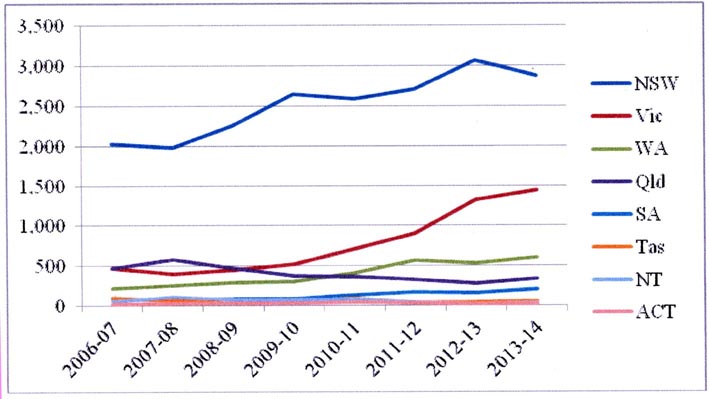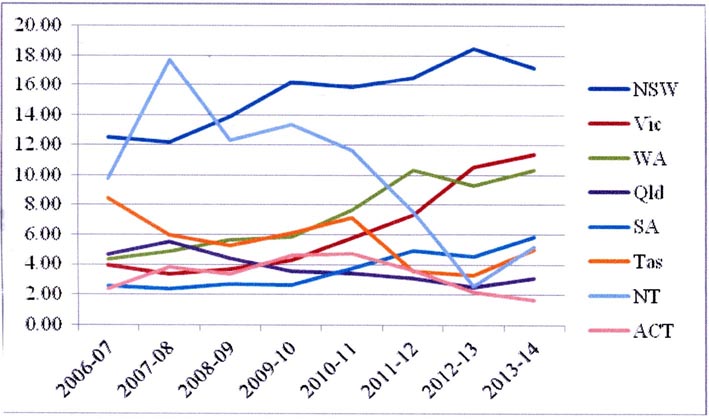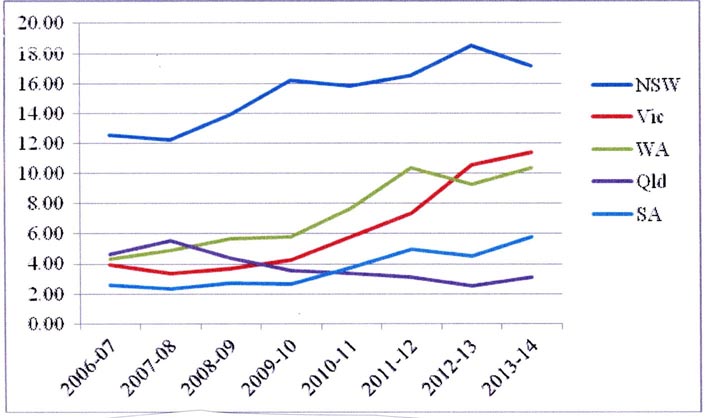|
mandaotry reportin in Australia
|
WHAT CAN WE LEARN FROM THE AUSTRALIAN DATA ON MANDATORY
REPORTING OF CHILD SEXUAL ABUSE?
- Pat Yudkin
Summary
To attempt to gain some insight into the possible effects of mandatory reporting
of child sexual abuse (CSA) I investigated data from Australia. Of the eight
states and territories of Australia, seven had mandatory reporting of CSA in
place before 2005. Western Australia introduced mandatory reporting of CSA in
January 2009. I hypothesized that there would be a rise in identified cases of
CSA in Western Australia after 2009 that was not matched by rises in the other
jurisdictions.
I examined trends in the incidence of substantiated CSA over the eight years
2006-07 to 2013-14. I found the expected rise in cases of CSA in Western
Australia, but this was matched by comparable rises in other jurisdictions,
notably New South Wales, Victoria and South Australia. Further, throughout the
period, New South Wales showed an unusually high incidence of CSA compared with
the other jurisdictions.
There is wide variation, both across jurisdictions and over time, in the
substance of the mandatory reporting laws relating to CSA. Similar variation
exists in the interpretation and implementation of these laws in practice, the
organization of child protection services and the resources available. For all
these reasons, routinely collected data needs careful and painstaking
interpretation. It is simplistic to assume that such data can be used to assess
the impact of a single legal change.
Comparisons between jurisdictions, between countries, and across time periods in
the same jurisdiction, using routinely collected data, will not have a simple
interpretation.
METHOD
To attempt to gain some insight into the possible effects of mandatory reporting
of CSA, I investigated data from Australia. I used Australian day for several
reasons. First, detailed data on CSA is published annually in the reports “Child
Protection Australia” from the Australian Institute of Health and Welfare (1).
All these reports are available online. Second, a number of influential papers
on mandatory reporting of CSA in Australia have been published by Professor Ben
Mathews of Queensland University of Technology. Extracts from papers by
Professor Mathews have been used in support of mandatory reporting of CSA on the
website of the pressure group Mandate Now (2).
Of the eight states and territories in Australia, seven had mandatory reporting
of CSA in place before 2005. The eighth, Western Australia, introduced mandatory
reporting for CSA on 1st January 2009. I examined data on CSA in Australia over
the period 2006-2013. I hypothesized that there would be a rise in identified
cases of CSA in Western Australia after 2009 that was not matched by rises in
the other jurisdictions.
Source of data
The two main sources used were the report by Professor Mathews for the Royal
Commission into Institutional Responses to Child Sexual Abuse, 'Mandatory
Reporting Laws for Child Sexual Abuse in Australia: a Legislative History' (3),
and the annual reports “Child Protection Australia”, from the Australian
Institute of Health and Welfare (1). I covered the eight-year period 2006-07 to
2013-14, avoiding data from earlier years because, for Victoria, the earlier
data is not consistent with that from 2006-07 onwards (4). The data relates to
children aged 0 to 17 years throughout.
Mandatory reporting of CSA: differences in legal requirements across the eight
Australian jurisdictions
The report for the Royal Commission (3) highlights the many differences between
jurisdictions in the history and present day situation of the mandatory
reporting laws, summarised below.
When was mandated reporting of CSA introduced?
Mandatory reporting laws specifically for CSA were introduced as follows:
Northern Territories INT) 1984; Tasmania (Tas) 1987; New South Wales (NSW) 1988;
Victoria (Vic) 1993; South Australia (SA) 1994; Australian Capital Territory
(ACT) 19979 Queensland (Qld) 2004; Western Australia (WA) 2009. All
jurisdictions except WA also require mandatory reporting of other forms of child
abuse and neglect.
Over time, changes in legislation have occurred in all jurisdictions. At the
time of the royal Commission Report (August 2014) the legal requirements with
respect to CSA were as follows.
Who is mandated to report?
Teachers, doctors, nurses and the police are mandated reporters in all
jurisdictions except Qld, which mandates only doctors, nurses and teachers. WA
and Vic also include midwives. ACT and NSW include, in addition, a wide range of
paid professionals. SA and Tas go further in also mandating some volunteers. In
NT all citizens are mandated to report.
Apart from NT, SA is the only jurisdiction to include ministers of religion and
other workers in religious organizations (paid or voluntary), as mandated
reporters. Notably, a minister of religion is not required to divulge
information communicated in the course of a religious confession.
What is the definition of a child?
The reporting duty relates to children under the age of 18, except in NSW (under
16) and Victoria (under 17).
What level of sexual abuse must be reported?
It is mandatory to report all sexual abuse in ACT, NT, SA, Tas and WA. In NSW
and Vic, the child must be eat risk of ‘significant harm'. Qld has a dual
requirement: for doctors and nurses, there must be a risk of ‘significant harm',
but school staff are required to report all sexual abuse.
What time period does the abuse relate to?
Past or ongoing abuse must be reported in ACT and WA. In SA and Tas, the
likelihood of future abuse must also be reported if this relates to a person
residing with the child. In NSW, NT, Qld and Vic, it is mandatory to report the
likelihood of future abuse as well as past and ongoing abuse.
How certain of abuse does the reporter have to be?
There are differences in the site of mind that a reporter must have before the
duty is activated. Some legislation uses the criterion of ‘belief on reasonable
grounds' (ACT, NT, Vic, WA) and some the criterion of ‘suspects on reasonable
grounds' (NSW, Qld, SA, Tas). Belief requires a higher level of certainty than
suspicion.
What are the penalties for non-reporting?
Since 2010 there has been no penalty in NSW. In NT, Qld, SA, Tas, Vic and WA,
there are fines for non-reporting, ranging from $1,408 in Vic to $26,000 in NT.
In ACT, there is a fine of $5,500, imprisonment of up to 6 months, or both.
Information available on CSA from annual reports ‘Child Protection Australia’
Notifications. investigations and substantiations of
CSA
The Child Protection reports are detailed and comprehensive, and cover many
aspects of child protection. They refer to the numbers of ‘notifications’,
‘investigations’ and ‘substantiations' of child abuse. In all jurisdictions, not
all notifications of abuse will be investigated, and of those investigated, only
a proportion will be found to be substantiations, i.e. to meet the criteria for
child abuse. The criteria for recording an event as a ‘notification',
‘investigation’ or ‘substantiation’ vary across jurisdictions.
In practice, the numbers of these events depends not only on the legal
requirements, but also on factors such as how the law is interpreted, the
organization and efficiency of child protection services in each jurisdiction,
the resources available, etc.
Most of the published tables combine all forms of child abuse, i.e. physical
abuse, sexual abuse, emotional abuse and neglect. The reports do not include the
number of notifications or investigations specifically of USA. Neither do they
present information about the people making the notifications of CSA,
particularly whether or not they were mandated reporters.
For CSA alone, the reports record only the number of substantiated cases and the
number of children in substantiations (a child may be the subject of more than
one substantiated case.) The year runs from 1st July to 30th June.
An eight-year study of substantiations of child sexual abuse across the states
and territories of Australia
Results
Figure 1 shows, first, that the number of children in substantiations of sexual
abuse in New South Wales (NSW) was much higher than in any other jurisdiction.
Secondly, numbers rose throughout the period in New South Wales, Victoria (Vic),
Western Australia (WA) and South Australia (SA), and fell in Queensland (Qld).
Thirdly, numbers in Tasmania (Tas), Northern Territory (NT) and Australian
Capital Territories (ACT) were very small compared with other jurisdictions.
Table1.

Numbers of children in substantiations of child sexual abuse across the states
and territories of Australia.

The variation in numbers can partly be attributed to population size. New South
Wales has the largest population of all the jurisdictions, followed by Victoria,
Queensland and Western Australia.
And over the eight-year period, the population grew in all jurisdictions except
Tasmania. Figure 2 shows, for each jurisdiction, the numbers of children in
substantiations of sexual abuse per 10,000 children aged 0-17 in the population.
Table 2 Children in substantiations of sexual abuse: incidence per 10,000

children
After adjustment for population size, New South Wales remained an outlier, but
the incidence of child sexual abuse in the smallest jurisdictions and in South
Australia was no longer overshadowed.
The volatility in Northern Territory is difficult to interpret without further
information. The peak in 2007-08 represents 110 abused children; the trough in
2012-13 only 16. The incidence of CSA in Tasmania fell over the period and that
in the Australian Capital Territories rose and then fell back.
Removing the three smallest jurisdictions from the figure produces a clearer
picture in the larger states. The experience of Western Australia, where
mandatory reporting of CSA was introduced in 2009, is of particular interest.
Table 3 Children in substantiations of sexual abuse: incidence per 10,000 five
states

Throughout the period, the incidence of substantiated CSA in New South Wales was
considerably higher than in any of the other four jurisdictions. The incidence
of substantiated CSA rose over the eight-year period in New South Wales,
Victoria Western Australia and South Australia. There was a fall in the
incidence of substantiated CSA in Queensland.
As Western Australia introduced mandatory reporting in January 2009, I compared
the three years 2006-07 to 2008-09 with the five years 2009-10 to 2013-14. (The
first six months of 2009 would fall in the first period, and the second six
months in the second period.)
Table 4 Children in substantiations of CSA per 10,000 children, average
incidence per year

Between the two periods the average incidence of children in substantiated cases
of CSA in Western Australia increased from 5.0 per 10,000 to 8.8 per 10,000, an
absolute rise of 3.8 per 10,000. As Table 4 shows, greater absolute rises
occurred in New South Wales (4.0 per 10,000) and Victoria (4.3 per 10,000). In
relative terms the incidence rose 1.8 times in Western Australia, while the
incidence more than doubled in Victoria and rose 1.7 times in South Australia.
I considered whether the increases in identified cases of CSA in New South
Wales, Victoria and South Australia and the fall in Queensland could be related
to changes in their mandatory reporting laws in the eight-year period.
In New South Wales three legal changes occurred, all in 2010. These were the
introduction of ‘significant harm' (instead of ‘harm’) to activate a reporting
duty, the removal of a penalty for non- compliance with the law, and the
enabling of reports to be made to child wellbeing units. The first two of these
changes might be expected to decrease reports (and therefore substantiations) of
CSA, rather than increase them.
In Victoria there were two key legal changes in the period. In 2007 came a
clarification that ‘harm’ can be caused by a single act or omission, as well as
a series of acts and omissions. And in 2010 midwives were added as a mandated
reporter group. In SA in 2006, three additional groups were added to the list of
mandated reporters. They were ministers of religion, employees and volunteers in
religious organizations, and employees and volunteers in sporting or
recreational organizations.
These changes in Victoria and South Australia might be expected to have a
positive impact on reports of CSA, and thus on substantiations of CSA.
One key change in the law occurred in Queensland in 2012, when teachers were
required to report all cases of CSA and suspected cases of future CSA. This
change was too late to affect the observed fall in CSA incidence and in any case
would be expected to work in the opposite direction.
Discussion
There are marked variations across the states and territories of Australia in
many aspects of their mandatory reporting laws. The law were introduced at
different times, the earliest in 1984 (Northern Territory), the most recent in
2009 (Western Australia).
Differences are seen in the range of people mandated to report, the level of
abuse to be reported, the degree of belief that abuse has occurred (or may occur
in future), and the penalty for non-adherence.
There are differences between jurisdictions too in the interpretation and
implementation of the laws, the organization of child protection services and
the resources available. All these aspects vary not only across jurisdictions
but also over time.
In view of the high-profile cases of CSA in religious settings, it is notable
that ministers of religion and other workers in religious organizations (paid or
voluntary) are mandated reporters only in Northern Territory (where all citizens
are mandated reporters) and South Australia. In South Australia a minister of
religion is not required to divulge information communicated in the course of a
religious confession.
The current range of penalties for breaking the law is very wide, ranging from a
fine of up to $26,000 (Northern Territory) to no penalty at all (New South
Wales).
An examination of substantiated cases of CSA over the period 2006-07 to 2013-14
produced two main findings.
First, the incidence of CSA was consistently higher in New South Wales than in
any otherjuris diction.
Second, as expected, there was a rise in the incidence of CSA in Western
Australia where mandatory reporting was introduced in 2009. The rise occurred
throughout the period, but was more rapid after 2009 than before.
This would be consistent with an effect of mandatory reporting. However, as
similar rises in the incidence of CSA occurred in Victoria, New South Wales and
South Australia, where there were no major legal changes, it is clear that other
factors were in play. It would be simplistic to assume that the introduction of
mandatory reporting was responsible for the increase in substantiated CSA in
Western Australia.
Mathews et al. made this clear in their 2015 presentation to the Australasian
Conference on Child Abuse and Neglect (5). They pointed out that while
introducing a new legal duty can increase reports and substantiations of CSA,
these outcomes can also be influenced by non-legal contextual factors, such as
financial resources, personnel, child protection policy, and political pressure.
In general, the use of routinely collected data to provide information on the
working of a mandatory reporting law is fraught with difficulties. Comparisons
between jurisdictions, between countries, and across time periods in the same
jurisdiction, using routinely collected data, will not have a simple
interpretation.
References
1 . Australian Institute of Health and Welfare 2008. Child protection Australia
2006-07. Child welfare series no. 43. Cat. no. CWS 31. Canberra: AIHW; annually
to Australian Institute of Health and Welfare 2015.
Child protection Australia: 2013-14. Child Welfare series no. 61. Cat. no. CWS
52. Canberra: AIHW.
2. Mandate Now website: mandatenow.org.uk
3. Mathews B. (2014a). Mandatory Reporting Laws for Child Sexual Abuse in
Australia: a Legislative History, written for the Royal Commission into
Institutional Responses to Child Sexual able, Sydney.
ISBN 978-1-925118:5 7-5 (Print); ISBN 978-1-9251 18-58-2 (Online) 4. Australian
Institute of Health and Welfare 2009. Child protection Australia 2007-08. Child
welfare series n0.45 Cat. no. CWS 33. Canberra: MHW. Put 5. Mathews B, Bromfield
L, Walsh K, Vimpani G, Coe S. Mandatory reporting of child sexual abuse: 10 year
trends from a national study across reporter groups and different legal
frameworks. Presentation to Australasian Conference on Child Abuse and Neglect
(ACCAN), Auckland, 2015
Acknowledgement
1 am grateful to Professor Ben Mathews for bringing a number of helpful papers
to my attention and for sharing his expertise on this subject.
A note on the limitations of the data
The annual reports from the Australian Institute of Hea1th and Welfare (AIHW)
are based on the financial year July 1st to June 30th. Reported substantiations
relate only to substantiations of investigations started in the year and
completed by August 31st. Substantiations of uncompleted investigations are
never reported.
Based on the published data, it is difficult to determine whether or not this is
a serious issue. The proportion of uncompleted investigations of CSA is not
published. However, this information is available for all types of child abuse,
and it shows wide variation across jurisdictions.
Two jurisdictions of interest in this paper are New South Wales and Victoria. In
relation to all forms of child abuse, both had consistently good records over
the period 2006-07 to 2013-14. New South Wales completed over 95% of
investigations every year. Victoria completed well over 90% of investigations in
seven of the eight years (and 89% in the other year). The record in other
jurisdictions was more variable.
A comparison of the data published in the AIHW reports with that in a paper by
Professor Mathews (Mathews B (2014b). Mandatory reporting Laws and
Identification of Child Abuse and neglect: consideration of different
maltreatment types and a cross-jurisdictional analysis of child sexual abuse
reports.
Soc. Sci. 2014, 3:460-482. doi:10.3390/socsci303460) shows some quite large
differences. Professor Mathews used day provided directly by child protection
agencies in the various Australian states and territories. The annual number of
substantiations reported by Mathews was therefore not limited to substantiations
based on investigations started and completed during the year, as is the AIHW
data. Further investigation is needed to know whether this is the explanation
for the differences found but it is unlikely to affect the main thrust of my
conclusions.
|
Press back button on browser to return to the
HOME PAGE
| |




